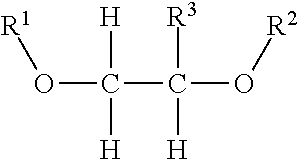Novel technology to coat fertilizer and improve fertilizer efficiency and their associated methods
a fertilizer and efficiency technology, applied in the field of liquid formulations, can solve the problems of increasing the cost of fertilization, the low efficiency of fertilizer, and the major problem of fertilizer efficiency, and achieve the effects of improving fertilizer efficiency, preventing the dissolution of fertilizer components, and being inherently safe for human conta
- Summary
- Abstract
- Description
- Claims
- Application Information
AI Technical Summary
Benefits of technology
Problems solved by technology
Method used
Image
Examples
example 1
[0160]157.43 grams of dicyandiamide is added to 299.4 grams of dimethyl sulfoxide, heated under agitation to 60° C. and held at 60° C. until mixture is clear. The mixture is cooled to 40-45° C. and then 42.17 grams of paraformaldehyde is slowly charged. The batch is held at 45-55° C. for 1.5 hours. The batch is then heated to 60° C. over a one hour period. After 1 hour, 1.0 grams of methane sulfonic acid / 70% is charged and batch is slowly heated to 100° C. over a 3 hour period. A vacuum of 40 mm is applied for 30 minutes until distillation ceased, then batch is cooled to <60° C. and off-loaded. Product is clear and viscous.
example 2
[0161]274.12 grams of dicyandiamide is added to 403.03 grams of dimethyl sulfoxide, heated under agitation to 60° C. and held at 60° C. until mixture is clear. 97.91 grams of paraformaldehyde is slowly charged. The batch is held at 60° C. for 9 hours until batch is somewhat clear. The batch is then heated to 80° C. over a one hour period. After 1 hour, 3.72 grams of methane sulfonic acid / 70% is charged and batch is slowly heated to 100° C. over a 1.5 hour period. The batch is heated to 110° C. and a vacuum of 135-140 mm is pulled for a 15 minute period. The batch is then heated to 120° C., a vacuum of 135-140 mm is applied for 35 minutes until distillation ceased, then batch is cooled to <60° C. and off-loaded. Product is clear and viscous.
example 3
[0162]117.6 grams of dicyandiamide is added to 99.4 grams of dimethyl sulfoxide and heated under agitation to 85° C. over a 45 minute period. 31.5 grams of paraformaldehyde is charged and then 1.49 grams of methane sulfonic acid / 70% is charged. The batch is slowly heated to 150° C. over a 3.5 hour period. The batch is heated to 110° C. and a vacuum of 135-140 mm is pulled for a 15 minute period. The batch is cooled to <60° C. and off-loaded. Product is clear and viscous.
PUM
| Property | Measurement | Unit |
|---|---|---|
| molecular weight | aaaaa | aaaaa |
| temperatures | aaaaa | aaaaa |
| temperatures | aaaaa | aaaaa |
Abstract
Description
Claims
Application Information
 Login to View More
Login to View More - R&D
- Intellectual Property
- Life Sciences
- Materials
- Tech Scout
- Unparalleled Data Quality
- Higher Quality Content
- 60% Fewer Hallucinations
Browse by: Latest US Patents, China's latest patents, Technical Efficacy Thesaurus, Application Domain, Technology Topic, Popular Technical Reports.
© 2025 PatSnap. All rights reserved.Legal|Privacy policy|Modern Slavery Act Transparency Statement|Sitemap|About US| Contact US: help@patsnap.com



